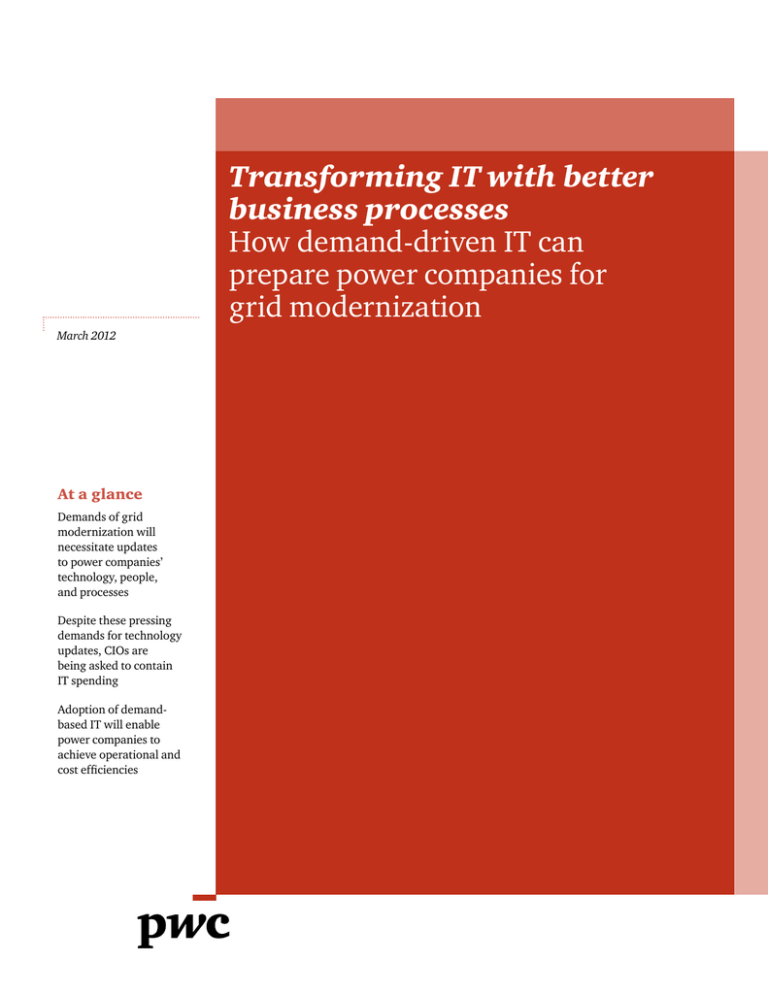
Transforming IT with better
business processes
How demand-driven IT can
prepare power companies for
grid modernization
March 2012
At a glance
Demands of grid
modernization will
necessitate updates
to power companies’
technology, people,
and processes
Despite these pressing
demands for technology
updates, CIOs are
being asked to contain
IT spending
Adoption of demandbased IT will enable
power companies to
achieve operational and
cost efficiencies
As external forces like smart meters change the face of the power
industry, power and utility companies are making significant
investments in technologies so that business decisions can be made
using information that is reliable, timely, and actionable. But CIOs are
being asked to contain IT spending in an economy that has been slow
to shake off negative consequences of the economic recession.
Planning for internal demand of
IT services
Business stakeholders may generally
be satisfied with the services that IT
provides. But ask CEOs, and many will
tell you that the organization should
have an increased focus on the value IT
provides to the business.
And that’s a problem in today’s tough
economic reality. Power companies
face cost pressures as public utility
commissions carefully weigh rateincrease requests, and CEOs ask
divisions to “do more with less.”
The truth is, they are often right.
To accomplish this, CIOs must
examine IT spending through a new
perspective. We believe that view
should focus on the internal demands
for IT services.
The IT infrastructure of power and
utilities companies is extremely
complex. The changing nature of the
business dictates this. Accordingly,
large, complex systems can, naturally,
be clogged with inefficiencies and
redundancies that consume a large
amount of operating expenses. These
inefficiencies have grown in sync with
the demands of internal business
units, resulting in a haphazard
“accidental architecture” in which
complexity continues to inflate
operating expenses.
2
How demand-driven IT can prepare power companies for grid modernization
In most power companies, demand
for IT services receives scant scrutiny.
It’s easy to see why: Requests for IT
services are often decentralized and
loosely governed. Consequently, CEOs
and business leaders—and in many
cases, CIOs themselves—may not be
completely aware of the real costs
of providing IT services to internal
business units.
The triggers for cost reduction
and change
Smart meters and other external forces
undoubtedly will change the face of
the power industry, but they will also
necessitate far-reaching updates to
the companies’ technology, people,
and processes.
Today, an outdated IT infrastructure is
the norm at many power companies.
These aging systems are simply unable
to accommodate the demands of grid
modernization on billing, accounting,
and communications technologies.
As a result, CIOs cannot effectively
prepare for future needs such as realtime, two-way communications with
customers and analytics of new types
of data.
• The accelerated installation of smart
grids and smart meters will trigger
an avalanche of data—an increase
estimated to be as large as 900%,
according to Lux Research.1 This
data will be key to understanding
customer needs and creating a more
efficient energy distribution system,
but it will be useless without tools
that can aggregate and analyze data
on customer usage, management of
power demand, load control, and
regulatory issues, allowing for better
decision-making.
• The smart grid also will demand
that power companies interact with
customers using real-time, twoway communications. Connected
customers will soon expect power
companies to provide real-time
information on service outages,
1 Lux Research, The Data Revolution: How
Intelligent Hardware Will Drive the $34 Billion
Smart Grid, December 2010
repair schedules, and usage details
to help them control their individual
costs. Beyond that, customers will
expect responsive and pervasive
digital customer service via email,
smart phone apps, and socialnetworking tools.
• Consumer adoption of electric
vehicles (EVs)—and the need to
deliver and manage the electricity
on which they run—will drive
changes at many power companies.
As more EVs hit the roads, power
and utilities companies worry about
what will happen when thousands
of EV owners simultaneously charge
their cars. According to EPRI,
dedicated, pole- or wall-mount
240V chargers produce a minimum
of 3,000 watts—about the same
power draw as a clothes dryer or an
air conditioning system.2 To ensure
that the grid doesn’t collapse under
an increased load, power companies
will need to implement technology
that can monitor use and predict
demand for power.
• Regulatory demands from the
state, as well as those at the
federal level, such as greenhouse
gas emissions, will require power
companies to update their systems
to accommodate new types of
reporting and management
capabilities.
• Cyber terrorists are fully committed
to understanding a company’s IT or
operations environment to achieve
their malicious objectives. Power
companies wanting to better protect
themselves and their stakeholders
from advanced cyber threats need
to adapt to new cyber security
requirements.
• At the same time, power and
utilities companies are facing a
loss of critical knowledge as many
long-term employees approach
retirement age, which will create
a serious talent squeeze for skilled
technicians and engineers, requiring
power companies to capture and
transfer knowledge of these longterm employees.
Despite these pressing demands for
technology updates, CIOs are being
asked to contain IT spending in an
economy that has been slow to shake
off negative consequences of the
economic recession. When spending
cuts are necessary, CEOs often focus
on IT costs because the department
represents a big spend—and most
executives don’t understand the
real cause and value of IT spending.
Holding tight reins on IT spending
can stall adoption of new technology
and hinder maintenance of the IT
infrastructure.
Bottom line: Increased external
pressures combined with internal
mandates have created an
environment in which a more efficient
IT infrastructure is more important
than ever.
2 Electric Power Research Institute, Plugging In: A
Consumer’s Guide to the Electronic Vehicle, 2011
Transforming IT with better business processes
3
The cultural impact of demand-based IT
We believe that adopting a demandmanagement approach to IT will not
only help control operating costs but
also improve relationships between IT
and the business units it serves.
A demand-focused model for IT
services, however, represents a seismic
cultural shift that goes far beyond
simple alterations to technologies or
processes. To prepare for the future,
CIOs must rethink their strategy
for governance of technology
infrastructure and services.
PwC believes that business leaders
and IT must agree to a commitment
of holistic governance. Ideally,
an executive council comprising
leaders from finance, transmission,
distribution, and operations, as well
as executive management such as
the chief financial officer and chief
operating officer, should collectively
debate and determine major IT service
requests. A solid governance structure
is critical to controlling the demand
of business needs yet, as many CIOs
know, governance is rarely as mature
(or simple) as it should be.
4
How demand-driven IT can prepare power companies for grid modernization
Creating an environment of
cooperation among business leaders
across the enterprise should be a
priority. Collective decision-making
on IT service requests will become
the norm, and stakeholders must
recognize that decisions must benefit
the organization as a whole.
In addition, holding internal
customers—people—accountable
for the IT services they consume
represents a new way of doing
business. In a transparent demanddriven model, the responsibility for
IT costs shifts to business units. As
business stakeholders realize the
cost consequences of their IT service
consumption, the organizational focus
shifts to a culture in which business
units work with IT to minimize
spending. In the long term, savings in
operational spending can be redirected
to a roadmap for improving the IT
infrastructure.
Uncovering low-value-add costs
A demand-centric model that makes
the services and costs of IT transparent
to both the CEO and business units can
help companies eliminate low-valueadd spending and trim IT operating
costs by as much as 20%. It also can
help an organization holistically
manage IT assets and ultimately foster
a culture of IT cost awareness.
To identify low-value-add costs, the
CIO must first assess the service
expectations that each internal
business unit places on IT. The
mission of the CIO is to simplify
the infrastructure by using fewer
applications that deliver the right
mix of value and performance. It
is here that the primary source of
low-value-add costs—duplication of
applications—will become apparent.
When identifying and eliminating
redundant low-value-add applications,
the CIO must work closely with
business leaders to assess and justify
the need for each application.
PwC has seen that certain
applications (See Figure 1) and data
centers are needlessly duplicated
across the ecosystem, consuming
disproportionate percentages of the IT
budget. Today, many of these systems
can be managed with enterprise
applications rather than disparate,
siloed systems.
How applications are duplicated at power companies (Figure 1)
While the number and configuration of applications vary with each power company,
PwC has found that these types of application proliferation are common. Duplication
is typically the result of mergers and acquisitions, as well as a lack of management
of demand.
Type of Application
requirement
Causes and concerns
Typically
installed Realistic
Asset management
application*
Due to specialized needs, power
companies do not efficiently manage
assets across the enterprise and lack
appropriate processes for physical
management of assets. As a result,
multiple systems are used to track
scattered assets across divisions
3 to 5
1 to 2
instances instances
Work management
application
Work management apps are very
specialized and unique to multiple
divisions. These apps often must
integrate with asset management
systems to integrate completion
of tasks.
3 to 5
1 to 2
instances instances
Customer
information
Systems (CIS)
As a result of M&As, power companies
often have multiple CIS tools that
add complexity and waste IT funding.
The smart grid will require that power
companies have an integrated CIS for
dynamic billing.
2 to 4
1
instances instance
Project portfolio
IT, distribution, and generation divisions
management (PPM) often have separate PPM applications
for small, medium, and large projects.
3 to 7
2
instances instances
Outage-demand
application
M&As have resulted in multiple outage— 2 to 3
1
demand systems that are not integrated. instances instance
Mobile field-force
applications
1
These apps are not viewed as enterprise 1 to 2
instances instance
solutions, resulting in multiple mobile
apps. Multiple instances do not allow
sharing of work across business units.
* Refers to physical asset management tools, not financial asset management.
Source: PwC
Transforming IT with better business processes
5
When taking the first steps to
rationalize applications, work
management and asset management
applications are an easy, logical
starting point. Yet the difficulty
of this process should not be
underestimated. PwC has observed
that any consolidation of applications
will require considerable institutional
change management skills to enable
divisions to successfully and fully
implement consolidations.
To be sure, this initiative can lead to
some difficult conversations. Asking
business unit leaders to alter solutions
that deliver satisfactory functionality,
no matter the efficiency or cost will
not be a popular request—particularly
if the business stakeholders don’t
understand how duplicated
solutions affect IT costs. Accordingly,
information technology leaders must
be well-prepared to articulate the cost
consequences of duplicated products
or services.
6
Additional sources of
low-value-add costs
PwC has seen that most organizations
do not efficiently utilize the capacity
of installed hardware. A typical
power company, for instance, spends
thousands of dollars for a server that
is not optimally utilized. Virtualization
would enable the business to
dramatically boost utilization and
efficiency, maximizing investments
in hardware and help control
operating expenses. The company
also will spend less on ancillary
costs such as electricity to power
the IT infrastructure and cooling of
data centers.
We have also seen inefficient use of
hardware at power companies that do
not rationalize hardware requests from
business units. A division, for example,
may request nonstandard desktop
workstations that increase purchase
costs and needlessly complicate
IT support. Assuming there is no
compelling business reason for use
of nonstandard workstations,
the CIO can better manage his/
her organization by requiring that
divisions use standard systems.
How demand-driven IT can prepare power companies for grid modernization
Service-level expectations that are
inconsistent with actual needs can also
be a cause of low-value-add spending.
We have seen that organizations
often seek high-performance service
levels that simply are not financially
defensible when the value provided is
carefully assessed against real needs
and costs.
For instance, companies that outsource
storage of noncritical, historical
data incorrectly assume that they
require the highest reliability. The
reality is, certain outsourced data
storage services—those offering
real-time recovery, high-speed SANs,
or dedicated servers—are costly and
superfluous for historical or tier-three
data. CIOs should consider the types of
service levels needed based on factors
like demand level and make decisions
based on real needs for each data type.
Taking a stand on demand-based IT
The opportunities
of the cloud
Forward-thinking companies
should begin to explore
applications and data
that are appropriate for
cloud computing, keeping
in mind the deluge of data
that a modernized power
grid will deliver. Cloudbased data storage and
analytics represent an ideal
opportunity to achieve cost
and operational efficiencies.
Many companies, for
instance, retain decadesold billing records or other
noncritical data that could
be stored in cloud-based
data centers.
Adoption of demand-based IT
services is not without challenges,
and it may necessitate investments in
technology and change management
initiatives. It will most certainly
require that power and utilities
companies take a hard look at how
to better manage business demands
on IT, eliminating inefficiencies and
redundancies to achieve operational
and cost efficiencies.
That won’t be easy. It will be, after all,
an entirely new way of doing business
for most organizations.
But as the power grid is modernized,
the price of doing nothing will be
steeper over the long term. PwC
believes organizations that ignore the
seismic shifts in grid modernization
will forfeit the opportunities to create
new competitive advantages and
build a new level of engagement
with customers.
Power companies that
implement cloud computing
to targeted facets of their
business—particularly
those that are related to
the new deluge of customer
data that the smart grid
will deliver—will be in an
enviable position to provide
innovative services and
increased efficiencies.
Transforming IT with better business processes
7
www.pwc.com/us/utilities
PwC has a long history of helping power and utilities companies
realize efficiencies in their IT infrastructure and business
processes. Our understanding of power company operational
processes, regulatory issues, and business needs allows us to assist
companies in aligning operating processes with overall business
requirements. Our team of experts can help select and implement
business and IT solutions to enable your organization to achieve
its transformational potential.
For a deeper discussion of these issues, please contact:
Brad Bauch
Power and utilities principal
(713) 356-4536
brad.bauch@us.pwc.com
Jim Ramsey
Power and utilities director
(214) 999-1468
nathan.j.ramsey@us.pwc.com
Brian Roy
Power and utilities director
(206) 617-5668
brian.roy@us.pwc.com
Eric Schillig
Power and utilities director
(408) 817-8114
eric.schillig@us.pwc.com
© 2012 PwC. All rights reserved.“PwC” and “PwC US” refer to PricewaterhouseCoopers LLP, a Delaware limited liability partnership, which is a member firm of
PricewaterhouseCoopers International Limited, each member firm of which is a separate legal entity. This document is for general information purposes only,
and should not be used as a substitute for consultation with professional advisors. PM-12-0080 SL





